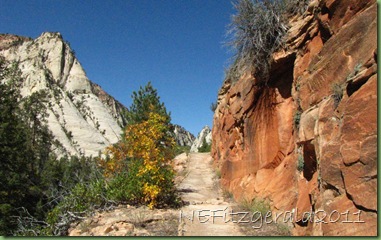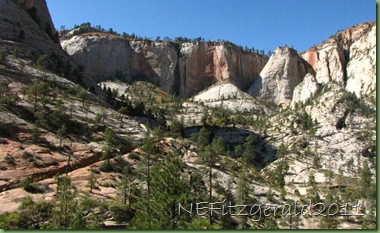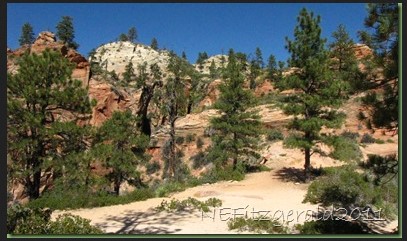Life grabs hold where it can in Zion National Park, in the shadowy crevasses of the bleached–white cliffs and desert varnish–streaked walls of Navajo Sandstone, here and there dotted with aromatic ponderosa pine, gnarly Utah juniper, and lingering high–desert wildflowers. An unhurried ramble past Scout’s Lookout on the West Rim trail offers anyone who is interested a first-rate display of this resolute late–October life.
 |
| West Rim trail weaves across Navajo Sandstone |
 |
| Life clings to the rocks |
 |
| Virgin River cuts deep in Zion Canyon |
Fluted fossilized dunes drift down from the sky and drape themselves gracefully hundreds of feet above the trail.
 |
| Fluted Navajo Sandstone sculpture |
Junipers tenaciously choreograph their roots through the cracks and joints of weathering sandstone.

One way or another, life survives and thrives in this arid wilderness of sculpted rock.
 |
 |
 |
The trail, carved into solid sandstone, meanders further into the backcountry and soon will start its climb to even higher reaches of the park.
 |
| West Rim trail snakes through Navajo Sandstone |
 |
 |
| West Rim trail ascends to rim of sandstone cliffs |
Every time I come to Zion I am awed and not a little overwhelmed by these towering sandstone cliffs, fossil remnants of a dune field that existed for some 10 million years during the Early Jurassic. In the sculptured cross–bedding of these ancient dunes we behold mere moments in time and space, a quick snapshot of events that occurred almost beyond the grasp of our imaginations. We study the rocks and try to understand them, of course, piecing together our interpretations bit by bit. That is what geologists do.
But this is Zion, one of the most unique landscapes on planet Earth. Its mystique will never be totally explained, even though science allows us astonishing glimpses into its history. The mystery and enchantment of these ancient rocks will remain. And at the end of the day, how could it be otherwise?






